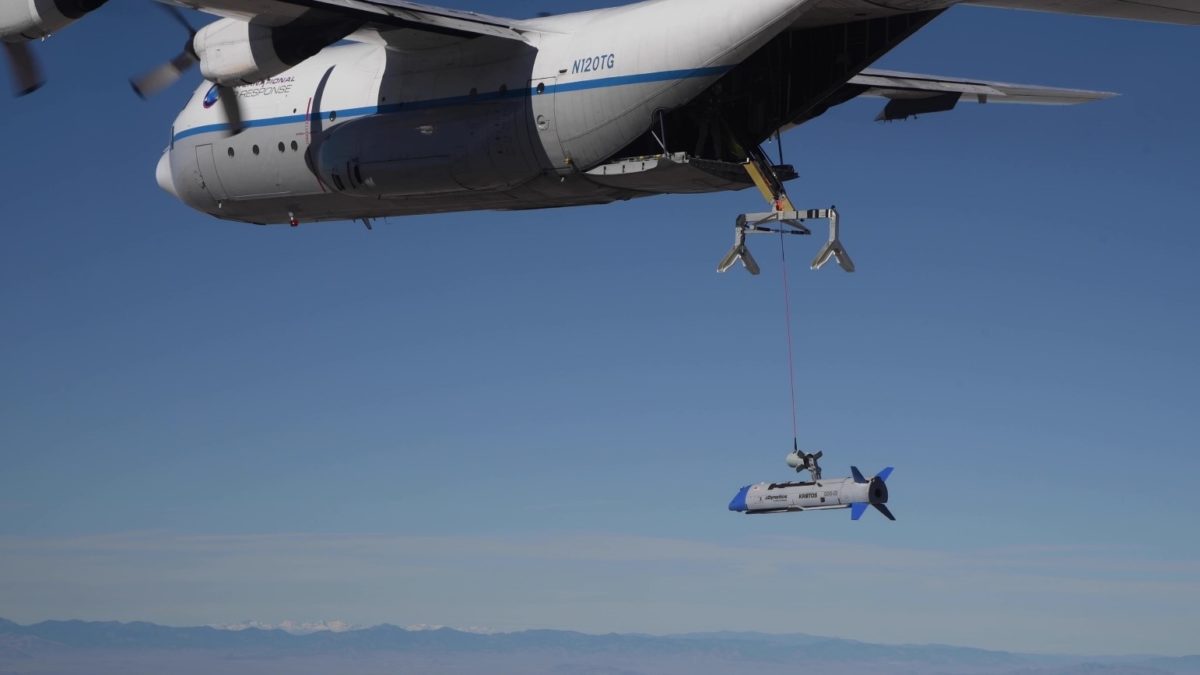After one Gremlin drone recovery, DARPA plans for more
By Cat Hofacker|November 9, 2021
Flights scheduled for early 2022, pending software changes
This story has been updated.
After the mid-air recovery of a Gremlin drone last month, DARPA and prime contractor Dynetics are preparing for a more ambitious flight demonstration next year: recovering four of them in 30 minutes.
The Oct. 29 flight, one of three conducted above Dugway Proving Ground in Utah, marked the first time an X-61A Gremlin Air Vehicle autonomously docked with a bullet-shaped port lowered via tether from a C-130A mothership to avoid collision risk. Multiple docking attempts failed during nine flights in 2020.
Dynetics program officials touted the flight as a breakthrough toward DARPA’s goal of demonstrating that the U.S. military could someday release swarms of small drones from cargo aircraft near hostile airspace and recover them after the drones penetrated the airspace to conduct reconnaissance.
“That one airborne recovery is the biggest hump to get over,” said Tim Keeter, Gremlins program manager at Dynetics, but a few more rounds of test flights are needed to prove that “operationally relevant rate” of four recoveries in 30 minutes.
Dynetics had hoped to recover all three drones after releasing them in succession from the cargo bay of the C-130. The first drone developed a “power problem” that Keeter declined to elaborate on and crashed when its abort parachute did not unfurl in time. During the second test, the Gremlin flew in formation behind the C-130 as if in preparation for docking, but out of an “abundance of caution” Dynetics decided to command the drone to parachute to the ground, Keeter said.
After the mid-air recovery of the third Gremlin, Dynetics refurbished that drone and flew it again on Oct. 31. This time, the docking was unsuccessful and the drone parachuted to the ground.
Dynetics is now analyzing the test flight data and will modify the Gremlins navigation software “to improve our probability of docking on first attempt,” he said. Depending on factors including range availability, the next flight could occur in early 2022.
Once multi-drone recovery is achieved, DARPA and Dynetics would move into the next round of flights in which test sensors would be installed on the Gremlins. Each drone has a 68-kilogram payload capacity, so DARPA plans to test different combinations of “sensors” it did not identify. During these flights, Gremlins would transit collected information to the C-130 mothership via a data link. When it’s time to retrieve the drones, the C-130 pilot would push a button on the instrument panel, commanding the Gremlins to fly in formation behind the mothership “like ducks behind their mother,” Gremlins avionics lead Morgan Kim said.
In the future, Keeter said artificial intelligence could be added to the flight computers of each drone to automate rendezvous, docking and other parts of flight, but the Gremlins test program currently has no plans to do so.
“What that might look like in a larger-scale conflict would be multiple sensors working together and fusing, that the Gremlins would carry into a contested environment, where right now even one operator could control up to four of those,” he said.





